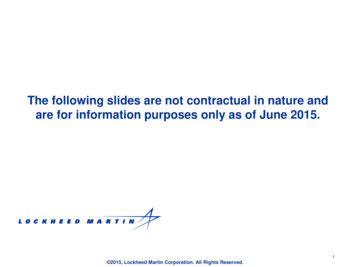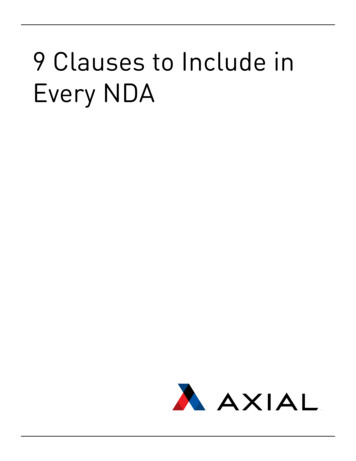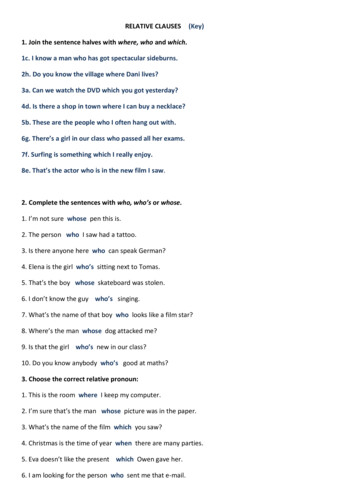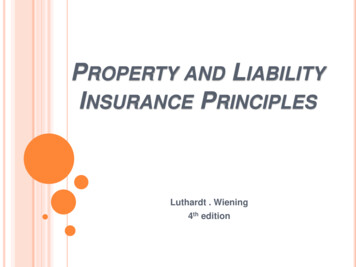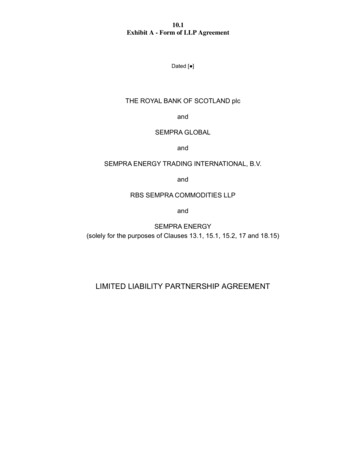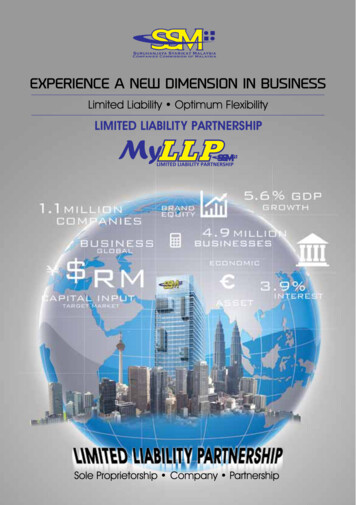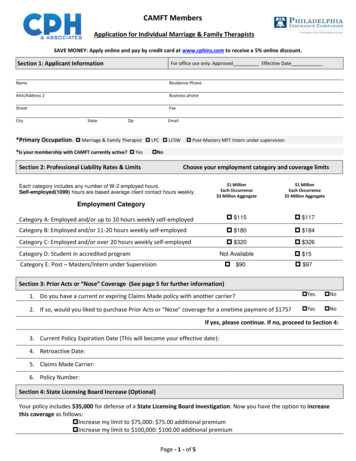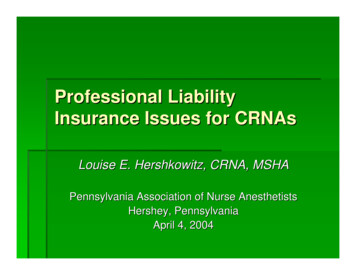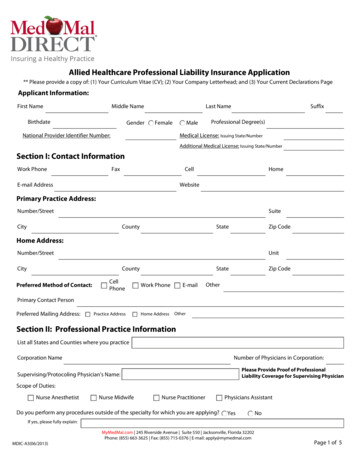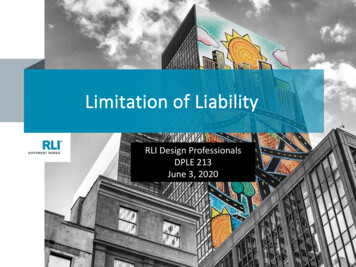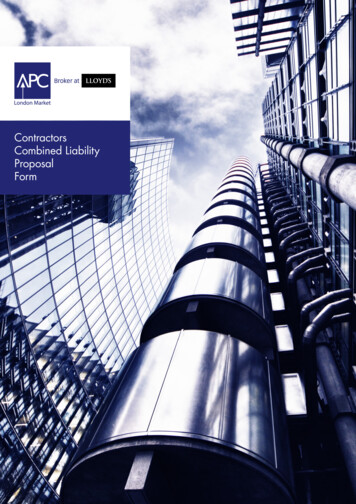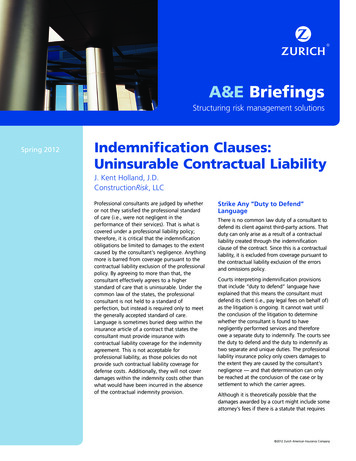
Transcription
A&E BriefingsStructuring risk management solutionsSpring 2012Indemnification Clauses:Uninsurable Contractual LiabilityJ. Kent Holland, J.D.ConstructionRisk, LLCProfessional consultants are judged by whetheror not they satisfied the professional standardof care (i.e., were not negligent in theperformance of their services). That is what iscovered under a professional liability policy;therefore, it is critical that the indemnificationobligations be limited to damages to the extentcaused by the consultant’s negligence. Anythingmore is barred from coverage pursuant to thecontractual liability exclusion of the professionalpolicy. By agreeing to more than that, theconsultant effectively agrees to a higherstandard of care that is uninsurable. Under thecommon law of the states, the professionalconsultant is not held to a standard ofperfection, but instead is required only to meetthe generally accepted standard of care.Language is sometimes buried deep within theinsurance article of a contract that states theconsultant must provide insurance withcontractual liability coverage for the indemnityagreement. This is not acceptable forprofessional liability, as those policies do notprovide such contractual liability coverage fordefense costs. Additionally, they will not coverdamages within the indemnity costs other thanwhat would have been incurred in the absenceof the contractual indemnity provision.Strike Any “Duty to Defend”LanguageThere is no common law duty of a consultant todefend its client against third-party actions. Thatduty can only arise as a result of a contractualliability created through the indemnificationclause of the contract. Since this is a contractualliability, it is excluded from coverage pursuant tothe contractual liability exclusion of the errorsand omissions policy.Courts interpreting indemnification provisionsthat include “duty to defend” language haveexplained that this means the consultant mustdefend its client (i.e., pay legal fees on behalf of)as the litigation is ongoing. It cannot wait untilthe conclusion of the litigation to determinewhether the consultant is found to havenegligently performed services and thereforeowe a separate duty to indemnify. The courts seethe duty to defend and the duty to indemnify astwo separate and unique duties. The professionalliability insurance policy only covers damages tothe extent they are caused by the consultant’snegligence — and that determination can onlybe reached at the conclusion of the case or bysettlement to which the carrier agrees.Although it is theoretically possible that thedamages awarded by a court might include someattorney’s fees if there is a statute that requires 2012 Zurich American Insurance Company
the same, attorney’s fees are generally not awardedas part of a judgment in the American system ofjustice. Therefore, a clause stating that theconsultant will defend (pay on behalf of) orindemnify (pay attorney’s fees after judgment isrendered) may create uninsurable liability. Agreeingto defend on behalf of a client, however, is the farworse situation. The consultantwould be paying out of itsown pocket its client’s.any duty to defendattorney’s fees as they arethe client pursuant to anincurred to defend against aindemnification clause.third-party claim. Ultimately,that claim might not even beis uninsurable.found to have been caused bythe consultant’s negligence.Typical advice to professional consultants from riskmanagers and insurance professionals is that anyduty to defend the client pursuant to anindemnification clause, or other provision of thecontract, is uninsurable pursuant to the contractualliability provision of the contract. Therefore, itshould be struck from the contract languageaccordingly.It is not good enough that the contract states thatthe duty to defend and indemnify is limited todamages resulting from the negligent performanceof professional services. Even where the trigger islimited to “negligent performance,” a court couldreasonably interpret the duty to defend to be sucha broad duty that the consultant could be expectedto begin defending a claim on behalf of its client(paying attorney’s fees as they are incurred) as soonas any allegations of negligence are made. Thiscould be true regardless of whether thoseallegations are frivolous and ultimately disproved.Although the results vary by state, it is generally thecase that the duty to defend that is agreed to aspart of an indemnification clause is comparable tothe duty to defend that an insurance carrier haspursuant to an insurance company. An insurancecompany doesn’t wait to see if you are negligentbefore defending you. Rather, the company defendsyou as the battle is being waged in the hope ofproving you are not negligent. Waiting untilnegligence has already been proven before startingthe defense would be like waiting until the war hasbeen lost before deciding to join the battle. Thesame principle applies to defense duties assumed bya consultant in an indemnity clause. 2012 Zurich American Insurance CompanyCourt Decisions Enforcing theDuty to DefendA California Supreme Court decision in the case ofCrawford v. Weather Shield provides a clear analysis ofhow the duty to defend differs from the obligation toindemnify. The trial court in the underlying casedetermined that since the jury found Weather Shieldwas not negligent, the indemnification obligation wasnot triggered. On the other hand, the court foundthat the duty to defend was triggered by the initiationof the lawsuit insofar as claims concerned thewindows supplied by Weather Shield, regardless ofwhether a jury ultimately found Weather Shield wasnot negligent. This decision was affirmed on appeal tothe California Supreme Court, which stated:We focus on the particular language of thesubcontract. Its relevant terms imposed two distinctobligations on Weather Shield. First, WeatherShield agreed “to indemnify and save [its client]harmless against all claims for damages to personsor to property and claims for loss, damage and/ortheft growing out of the execution of [WeatherShield’s] work.” Second, Weather Shield made aseparate and specific promise “at [its] own expenseto defend any suit or action brought against [itsclient] founded upon the claim of such damage, loss, or theft.” (Italics added.)We agree with the Court of Appeal majority that,even if strictly construed in Weather Shield’s favor,these provisions expressly, and unambiguously,obligated Weather Shield to defend, from theoutset, any suit against [its client] insofar as thatsuit was “founded upon” claims alleging damageor loss arising from Weather Shield’s negligentrole in the Huntington Beach residential project.Weather Shield thus had a contractual obligationto defend such a suit even if it was laterdetermined, as a result of this very litigation, thatWeather Shield was not negligent.The court further stated:A contractual promise to “defend” anotheragainst specified claims clearly connotes anobligation of active responsibility, from the outset,for the promisee’s defense against such claims.The duty promised is to render, or fund, theservice of providing a defense on the promisee’sbehalf — a duty that necessarily arises as soon assuch claims are made against the promisee, andmay continue until they have been resolved. Thisis the common understanding of the word“defend” as it is used in legal parlance [citationsomitted]. A duty to defend another, stated in thatway, is thus different from a duty expressedsimply as an obligation to pay another, after thefact, for defense costs the other has incurred indefending itself.2
The court concluded that the defense obligationscontained in California civil statute “are deemedincluded in every indemnity agreement unless theparties indicate otherwise.” This means that formany California contracts, it is not sufficient tomerely strike out the “duty to defend” languagefrom the indemnification clause. Rather, it isnecessary to insert words to the effect that“Consultant shall not defend” the indemnitees.Since Crawford v. Weather Shield, other courtdecisions in California have followed the holding,including a Court of Appeals decision in the matterof UDC v. CH2M Hill that interpreted and applied anindemnification clause requiring a design professionalto defend its client even though a jury found nonegligence on the part of the professional. Thecourt’s conclusion was based on the fact that theprofessional services agreement between the partiesprovided that the consultant would “defend any suit,action or demand brought against Developer orOwner on any claim or demand covered herein.” Theengineer argued that under the contract, it had aduty to indemnify UDC only if it was found negligentin performing its work and had a duty to defendonly when the third-party suit alleged a claim thatdirectly implicated it. Because a jury found that theengineer was not negligent, the appellate courtagreed that the “negligent act or omission”language shielded the consultant from a duty toindemnify, but held that the engineer neverthelesshad a duty to defend the indemnitee againstthe claim.Agreeing to Pay ReasonableAttorney’s Fees as Part ofIndemnification May CreateUninsurable LossA question that is asked with increasing frequencyis whether attorney’s fees incurred pursuant to anindemnity clause are insurable where they are notincurred due to a duty to defend (i.e., paid onbehalf of the indemnitee) but are instead paid afterthe litigation is complete and the indemnitor (e.g.,engineer) is found liable for damages due to itsnegligence. The short answer is that unless thecourt would have awarded the attorney’s feesagainst the engineer in the absence of thecontractual obligation created by theindemnification provision, the attorney’s fees willnot be covered by the professional liability policy.The contractual liability exclusion of the policyapplies to such a contractually created attorney’sfees obligation.A typical indemnification clause that includespayment of attorney’s fees as part ofindemnification rather than as part of a duty todefend is as follows:3INDEMNIFICATION.for many California“The Consultant shallindemnify and holdcontracts.it is necessary toharmless Owner, its parent,insert words to the effectaffiliates and their respectivedirectors, officers andthat “Consultant shall notemployees (“Indemnitees”)defend” the indemnitees.from and against any and allclaims, suits, actions,judgments, demands,losses, costs, liability, damages, and expenses, ofany kind (including reasonable attorney’s fees)for injuries to persons (including but not limitedto death) or damage to property to the extentany of the foregoing are caused by any negligentact, error, or omission of Consultant, its officers,employees, agents, representatives, and personsfor whom Consultant is legally responsible in theperformance of the Services.”Although this clause may look innocuous in that theindemnification is limited to negligence, it maynevertheless create uninsurable loss by virtue of theattorney’s fees that are included in theindemnification. Under American Jurisprudence, thecourts do not award attorney’s fees to the prevailingparty unless the contract creates such a duty orunless there is some legal basis such as a civil statutethat would establish the basis for the award.To avoid contractual liability for legal fees under theabove-quoted clause (which would not be coveredby insurance), it may be necessary to revise the finalsentence to read something like the following:“Consultant shall have liability for reasonable andnecessary defense cost incurred by personsindemnified to the extent caused by Consultant’snegligence herein and recoverable underapplicable law on account of negligence.”Unless the award is limited tothe sum “recoverable underUnless the award is limitedapplicable law on account ofto the sum “recoverablenegligence,” the indemnity oflegal costs may not be fullyunder applicable law oninsured. Specifically, an awardaccount of negligence,” theof legal costs in favor of theindemnitee against theindemnity of legal costs mayengineer that is based on thenot be fully insured.contractual indemnity alone isexcluded from coverage by thecontractual liability exclusion of the policy. Theaward amount made under applicable law,respecting recovery of plaintiff’s legal costs andapart from the contractual indemnity, could becovered depending upon terms and conditions ofthe policy. 2012 Zurich American Insurance Company
In other words, if a state has a law for recovery ofplaintiff’s legal costs against the engineer, an awardunder that law based upon negligence might becovered under the professional liability policy.However, any part of an award of attorney’s feesthat results only from a contractual indemnityobligation to indemnify a plaintiff’s legal fees willrun afoul of the contractual liability exclusion of thepolicy and, therefore, be excluded from coverage.As previously stated, in theUnited States, the laws of the.agreeing to reimburse theindividual states do notindemnitee for attorney’sroutinely provide for an awardof plaintiff’s legal costs. That isfees will likely create anthe genesis of contractualuninsurable risk.indemnity of legal costs.Contractual indemnity “fills in”what the law does not otherwise order. Likewise,that is the reason the engineer would limit thecontractual indemnity to the sum that the state lawwould award. The “fill in” to enforce thecontractual indemnity is not a liability that wouldhave attached to the “insured” in the absence ofsuch contract, warranty, guaranty or promise, toquote from the contractual liability exclusioncontained in a typical insurance carrier’s policy. Forthe reasons explained in this article, a party thatagrees to indemnify another should beware thatagreeing to reimburse the indemnitee for attorney’sfees will likely create an uninsurable risk wherethose fees would not have been awarded by acourt in the absence of the contractual ob
The professional liability insurance policy only covers damages to the extent they are caused by the consultant’s negligence — and that determination can only be reached at the conclusion of the case or by settlement to which the carrier agrees. Although it is theoretically possible that the damages awarded by a court might include some attorney’s fees if there is a statute that requires .
